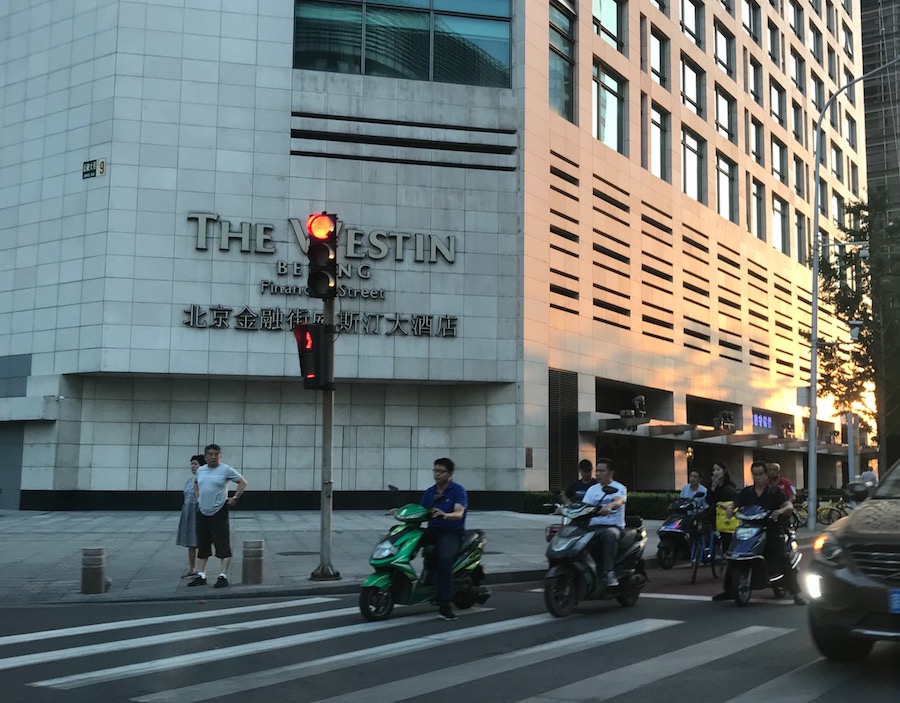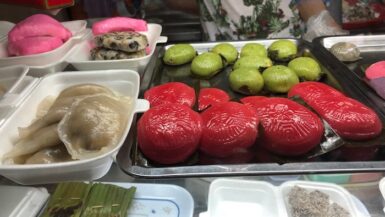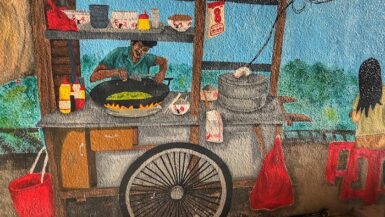August 29, 2018
We had been advised that, due to rush hour traffic, we should allow for up to an hour taxi ride, so we got down to the lobby an hour before we needed to meet our tour guide for our evening culinary tour. The only problem was we were third in line and the bellmen were having difficulty getting any taxis to stop.

As the minutes ticked by into 20 and then 25 minutes, I was a little antsy that we wouldn’t make it on time.

Finally, enough taxis stopped and we were on our way. Since most of the taxi drivers don’t speak English, we’d had the forethought to bring a copy of the address written in Chinese to present to the driver – very helpful. And then we were in the standstill of rush hour traffic, with our driver constantly muttering under his breath at the other cars (not sure what he was saying, but it didn’t sound like it was loving and kind). Although I called (via WeChat) to let our guide know we were stuck in traffic and might be late, we actually arrived at the designated time and spot with 30 seconds or so to spare.
Our UnTours guide, was not what I was expecting. Originally from the US, he moved to China about four years ago, learned Mandarin, taught English in rural China, and now works for a tech company leading food tours on the side. He was decked out in shorts and a t-shirt sporting pictures of steamed buns on the front.

The only other member of our group was a 20-something young lady from the Netherlands who moved to Beijing 6 years ago to complete her Masters degree in Mandarin Chinese, has made her home here and now teaches English in a local International school. She is also learning the ropes of the food tour business as she is in training to be the newest guide for UnTours.
Our culinary adventure took us through the narrow streets and back alleys of old Beijing’s hutongs. Little stores and restaurants with no visible signage line the alleyways and it’s safe to say that if you don’t know where you are going, you probably won’t find what you are looking for.

Our first stop was at one of the no signage restaurants to pick up a couple of orders of dumplings to go. Shortly thereafter, we arrived at our first sit down place where we enjoyed Mongolian Hotpot and the take-away dumplings. The tiny, one room restaurant was hot and sticky from the steam given off by the hot pots and Korean bbq grills, but nothing that a cool bottle of water couldn’t cure.

We were guided through the process of adding the spices, vegetables, tofu skin and finally the sliced lamb in the proper order so that everything cooked and was ready to be eaten at the same time. Our guide also took us through the proper way to prepare the hot pot dipping sauce – a mixture of Chinese sesame, leek, savory-sweet bean, and fermented soybean pastes and minced coriander/cilantro. Ultimately, the mixture becomes a delightfully earthy, not too sweet, not too spicy pot of goodness.
While we enjoyed the hot pot and something called “saucy meat” (braised garlic pork), the highlight was the dumplings – pork/Napa cabbage and Chinese chive/egg. Dipped in vinegar, they were soft and very tasty. I could have eaten all of them, but I had to share and knew that we had a full evening of food ahead.
Just before leaving the restaurant, our guide broke out a bottle of Baiju for us to try. Basically, it is moonshine in a bottle. Baiju can range from 45% to 65% alcohol; we were lucky, this bottle was on the low end of the spectrum. A tiny sip was enough for me to know that I didn’t want any more – it was blast your pants off strong and had an undertone of anise (I don’t like licorice). I’m sure that one small bottle could be the making of a really nasty hangover.

We made our way out of a little back alley and into the bright lights of the ghost street – a main thoroughfare lined with restaurants of every kind (with traffic to match). We only walked a short distance to a small shop that sold Old Beijing Yoghurt. It’s made fresh daily from an old recipe and then packed in jars with a paper lid. Once pierced with a straw, it becomes a thick dairy drink ~ a little sour from the yoghurt, but made sweet with honey. I found it to be very refreshing and yummy during our walk to our next destination. Don’t be worried about getting rid of the glass jars it comes in – you just leave them beside the base of a tree and someone will pick it up for recycling; it’s a thing.

We arrived at NuoYan, a trendy bar specializing in craft rice wines.

We were each presented with a flight of six rice wines, each having a different period of fermentation or infusion. Fermentation was anywhere from three months to two years; some were infused with plum, others were infused with rose. Although not a drinker, I sipped each to find that my favorite was fermented a year and a quarter in an oak barrel. Luckily, the alcohol content of the flight was only between 12-19%.

Back out on the ghost street, we were going to stop next at Fatty Wang’s, but our guide opted to put in an order to go when he saw the restaurant was packed with smoking partiers. Instead, we continued down the street to Qin Tang Wei Dao, a noodle house. Once we were settled in the noodle restaurant, he dashed back out to pick up our order from Fatty Wang’s.
What is Fatty Wang’s specialty? Donkey burgers – yes, you read that correctly, donkey burgers.

Surprisingly, the shaved donkey meat, surrounded by a puff pastry, not a bun, is very lean and, extremely tasty. With the right seasoning, it could actually pass for corned beef. Not advocating that everyone run right out and find a donkey to cook up, but if you’re ever offered a donkey burger, don’t pass it up.

Since we were at the noodle restaurant, we watched as the chef hand stretched large flat biang biang noodles (originating from Xi’an).

Pared with chilis, pork, bok choy, mushrooms and vinegar, the noodles were perfectly cooked, just the right degree of chewiness and yummy. One of the highlights of our culinary tour, second only to the dumplings.

Our last stop took us back into the dark alleys of the hutongs to Fifth Brother’s Chicken Wings, owned by Wuge, the fifth son of his parents. Wuge is affectionately known as “the chicken wing nazi” and runs his restaurant with an iron fist. You don’t get to enter the front door without a reservation (even if there are no other patrons). If you are lucky to have a reservation and enter the restaurant, you may not order any less than 20 skewers (two wings each) of chicken wings done in a combination of four spice levels.
If you dare to order the double-sided peppered wings, don’t let Wuge see you removing any of the pepper flakes from the outside to lessen the spiciness. If you order it, you eat it. I wimped out and went for the #2 level of spiciness.
In the end, I was full, but not too full, which is a great feat on a food tour. Before saying goodbye, our guide and his protege said they would help us get a taxi, but there were none to be had. Uber doesn’t work in China, but they have something similar called DiDi. Both of them got on their phones to summon DiDi, but it took about 20 minutes before anyone picked up the request – I guess no one wanted to drive to the Financial District. Our guide used his app to pay for our ride and we gave him the money to cover the cost.
Our ride pulled up and we hopped in. The only problem was that our driver, although in his 20s, didn’t speak any English. This may have not become an issue, but on our way back to the hotel, our driver got a bit turned around trying to follow his navigation app – he drove down a narrow alley lined with motor scooters and various other pieces of equipment only to find oncoming traffic with no way to pass. A long standoff ensued, neither direction of traffic wanting to give in. Eventually, after several outbursts in angry Chinese, our driver backed up the alley to find a different route. It was quite a stressful event. At one point, I was afraid he was going to give up and tell us to get out of the car – but, he didn’t. I can tell you, I was very happy to see our hotel come into view. Long exhale.











